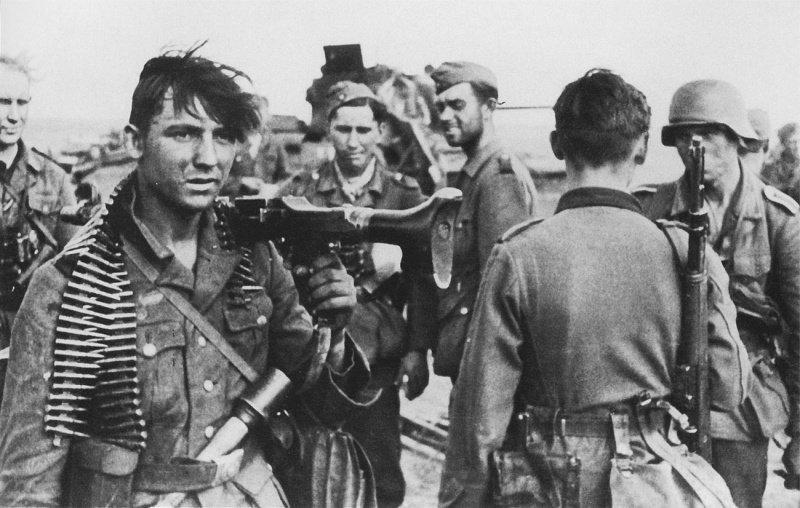
Stalingrad: City Fighting (September-October 1942)

Figure 1.--Hitler by ordering Paulis and the 6th Army into Stalingrad was surrendeing the principal advantages that the most powerfull German formation on the eastern Front possessed--mobil fire power and maneuevr. The bttle would become one of brutal urban warfare before small groups of German and Soviet soldiers. And this was a ckmbat environment in which individual Siviet soldiers proved adept. In the brutal house to house combat that ensued the courage and resourcefulness of the Red Army soldier proved to equal that of the NAZI supermen if not surpass them.
|
|
The 6th Army reached the suburbs of Stalingrad (September 13). The Red Army withdrew accross the Volga, but mainatined just enough forces in the city to steadily bleed the Germans. Small units of the Red ASrmy crossed the Volga under fire at night to reinforce the besiged garrison. Stalingrad was an important industrial city and a major transportation center for souther Russia. Hitler was also attracted by the name of the city. He felt seizing the city would be a propaganda blow to Stalin and his regime. By fighting in the city, however, the 6th Army's powerful mobil striking potential was negated by city terraine determined Red Army soldiers. Thus the Germans gave up much of their advantage. The battle for Stalingrad proper began in October. The struggle in Stalingrad was some of the fiercest and most brutal in World War II. Nor quarter was given. Prisoners were not taken. Without crossing the Volga, the Germans could not surround the city, an esential step in any seige. Even so, Hitler ordered the 6th Army to take the city. Fighting ensued for the Stalingradv 'kessel' raged from apartment to apartment and factory to factory. The Red Army's resistance was legendary. The city center had been reduced to rubble by the Luftwaffe, but the rubble offered invaluable cover for the defenders. The Germans met determined if not suicidal Russian ressistance. In the caulderon of Stalingrad all of the advantages of German mobility and superior tactics were lost. It was down to the tenacity and fighting spirit of indivudual soldiers. In the brutal house to house combat that ensued the courage and resourcefulness of the Red Army soldier proved to equal that of the NAZI supermen if not surpass them. The front lines was sometimes marked by an interior building wall or the floor of a building. The Whermacht which in 1941 might advance 50 kilometers in a day, now measured in gains in meters. At the end of September the 6th Army shifted its assaults from the southern and northern sections of Stalingrad to the northern sector where there were three emense concrete factories, including the famed Red October Plant producing tanks. At this huge tank factory, construction continued at one end even after the Germans had entered the other end. The 6th Army opened an offensive along a 3 mile front to finally seize the now largely destroyed city (October 3)
The Germans raised the swastika flag over the Univermag department store in the center of town. The Germans were reached the Volga in some sectors. The Russians held only a toe hold along the eastern bank of the river in other sectors and some industrial sectors (October 14). The Germans controled 90 percent of the city. To accomplish this, Paulus committed the last reserves of the 6th army. This left his flanks protected only by relatively weak Romanian divisions with no German support. Then the first frost set in and wiffs of snow begin to appear. Hitler announced to the German people that Stalingrad had been taken. "I wanted it and I now have it." Russian resistance, however, continued in scattered pockets as men and supplies were fed in nightly through the tiny bridgeheads under artillery fire.
HBC

Navigate the Boys' Historical Clothing Web Site:
[Return to Main Stalingrad page]
[Return to Main World War II campaign page]
[Biographies]
[Campaigns]
[Children]
[Countries]
[Deciding factors]
[Diplomacy]
[Geo-political crisis]
[Economics]
[Home front]
[Intelligence]
[POWs]
[Resistance]
[Race]
[Refugees]
[Technology]
[Totalitarian powers]
[Bibliographies]
[Contributions]
[FAQs]
[Images]
[Links]
[Registration]
[Tools]
[Return to Main World War II page]
[Return to Main war essay page]
Created: 6:28 AM 11/20/2013
Last updated: 6:28 AM 11/20/2013



